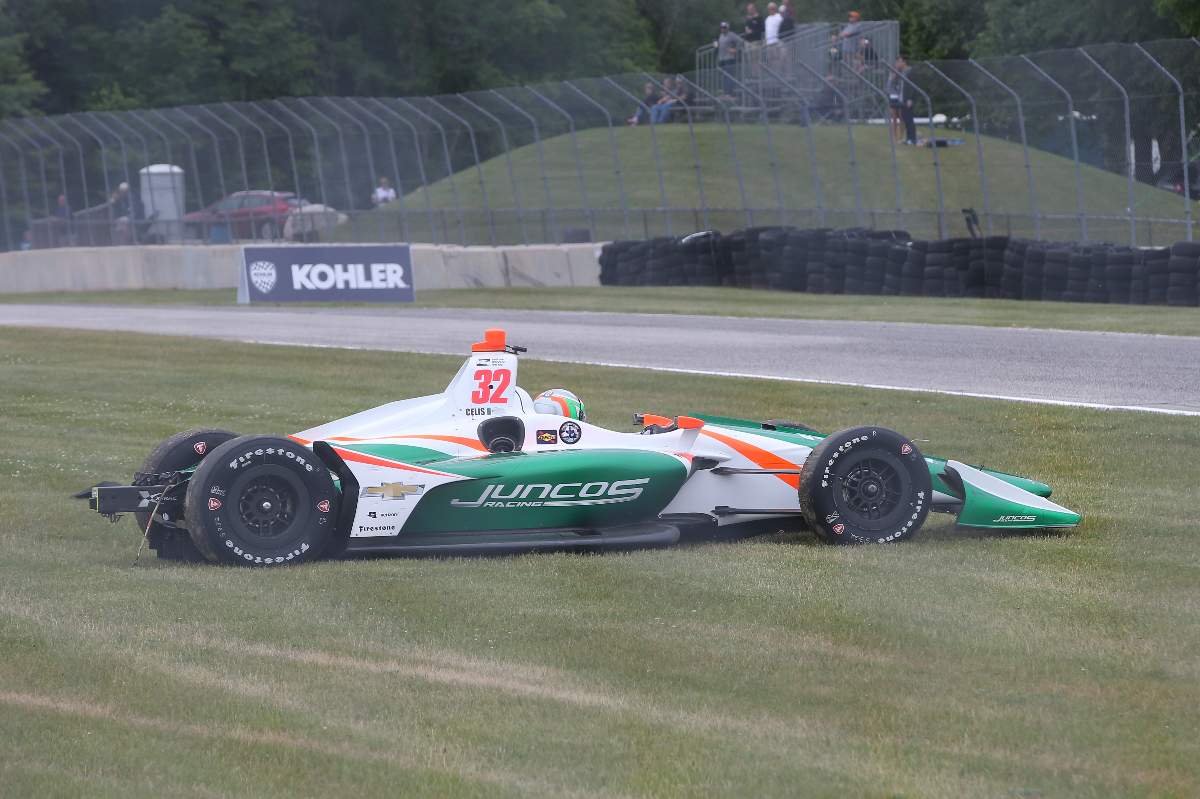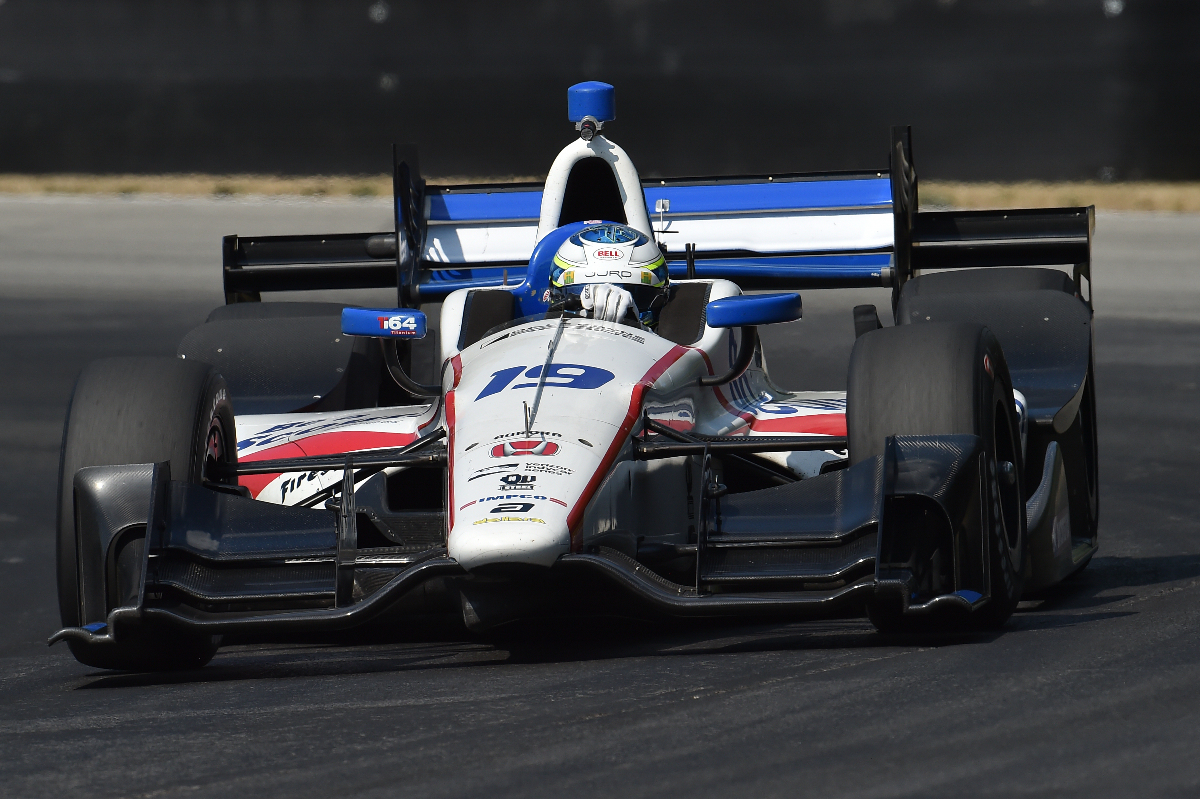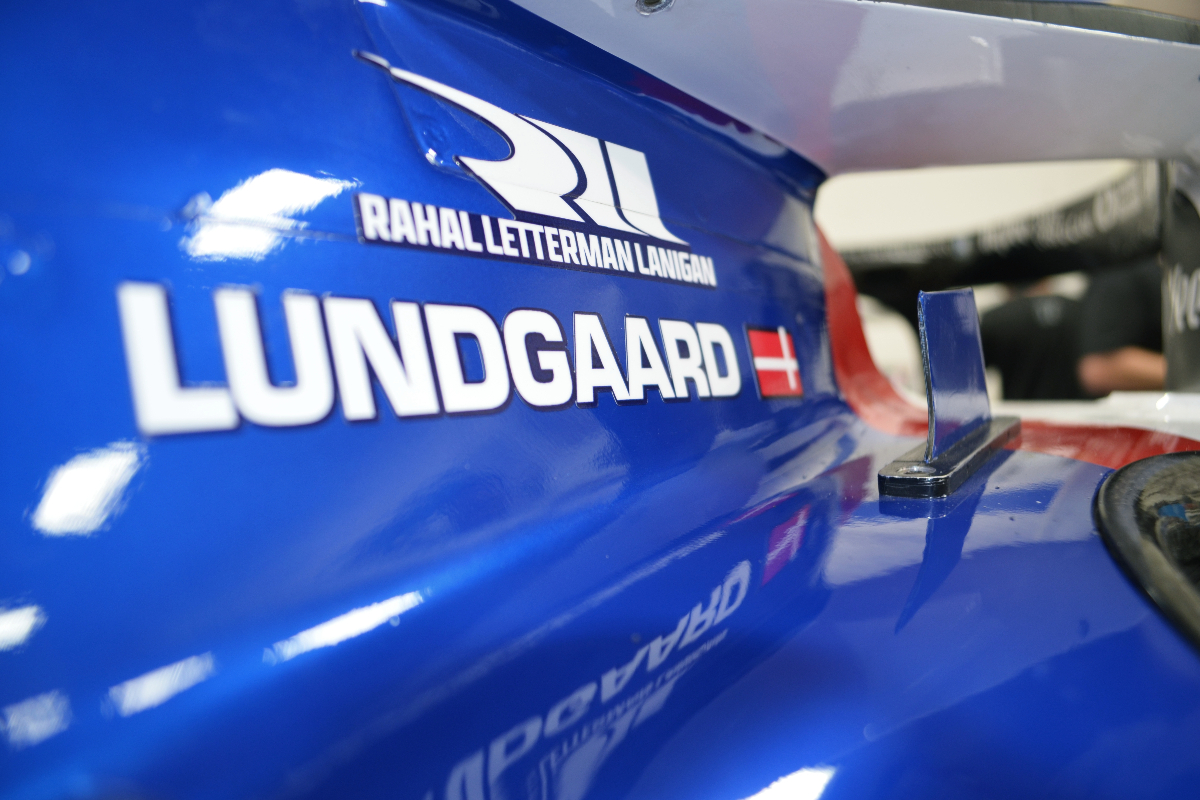
Photos: IndyCar
It’s harder than people think to land an IndyCar seat, even for a one-off, and it’s rare that drivers from the junior ranks can get themselves onto the grid mid-season. So is there a precedent for Lundgaard’s move?
After rumours of a test with Rahal Letterman Lanigan Racing last month, it was revealed on Monday that Alpine Formula 1 junior and Formula 2 race-winner Christian Lundgaard would be debuting in IndyCar in just a matter of days.
The Dane, with one day of experience in the 2021-spec version of the Dallara DW12 car (which has an aeroscreen as cockpit protection rather than a halo), will take the place of Santino Ferrucci in RLLR’s #45 car for this weekend’s race on Indianapolis Motor Speedway’s road course as the team tries to build up entrant’s points. It will run the car full-time in 2022, and there is a financial boost if the combined inputs of Ferrucci and Lundgaard make the #45 entry one of this year’s top 22 scoring cars.
The other contributing factor at RLLR’s end for having a driver in the car this weekend, as Ferrucci doesn’t bring money to fill the seat, is to evaluate who should be the primary occupant of the #45 next season. It’s believed that the two existing full-time entries have already been locked down for next year, leaving Ferrucci and Lundgaard as leading contenders for car three.
And is Lundgaard a genuine contender? It seems so, as the 20-year-old has already been linked to being in the car again this year and he has no F1 seat beckoning for 2022. He could spend a third year in F2, and while that isn’t yet under negotiation there are moves being made to keep Lundgaard in Alpine’s books for another year regardless of what race programme he ends up in. That’s important given his IndyCar debut in a Honda-powered car is coming with Alpine’s blessing.
But that can all depend on how Lundgaard performs on the day, so who can he look to previously who has jumped into the DW12 to race it during a season spent primarily racing in junior categories?
Santino Ferrucci USA 20y/o
2018: Racing in F2 (4 points) IndyCar debut: Ret and 20th in Detroit Junior return: F2 (3 points)

Photo: Joe Slibinski
It’s fair to say Ferrucci was a midfielder in every car he raced in until making it to the pinnacle of American single-seater racing. At that point, his elbows-out style, almost motorcycling-esque, gelled finely with a car known for its physicality.
After a half-season in F2 with Trident in 2017, Ferrucci stayed on in the championship and with the team for the year after as the current Dallara F2 2018 car was introduced. He and team-mate Arjun Maini, like Ferrucci a Haas junior, looked like they had reason to smile after encouraging pre-season tests but that was the last time there was much good feeling in the team.
The pair benefited from the usual Baku chaos to bag points there but were otherwise struggling to be competitive when not combating engine issues. After being thoroughly bettered by Maini in Monaco, Ferrucci spotted an avenue of redemption in IndyCar when Pietro Fittipaldi’s double leg-break in a sportscar crash opened up a seat at Dale Coyne Racing for the Detroit double-header.
Ferrucci found the money to fill the car and returned to America for his first race on home soil in almost five years. Straight away he turned heads by going sixth fastest in the first free practice session, on one of IndyCar’s trickiest circuits, then was 18th fastest and second-best rookie in the faster FP2. He qualified down the order and was running in 14th in the final stint before being nerfed out at high-speed.
The next day he fared better in a very wet qualifying session, meaning he started ahead of team-mate Sebastien Bourdais, and ran as high as seventh before his first pitstop but crashed immediately as he exited the pits, requiring another stop and putting him down a lap that he wouldn’t reclaim.
He then returned to F2, where things got worse as tensions reached boiling point at Trident. Maini let out his frustrations on the radio at Paul Ricard, while Ferrucci did it by hitting his team-mate on track at Silverstone and earning a two-round ban in a weekend where he was also fined for using his phone while driving to the grid. Trident then terminated Ferrucci’s contract and took court action against him for unpaid racing fees.
Despite being unable to pay for his F2 ride, he was back in IndyCar with Dale Coyne for the final two rounds and starting a partnership with four-time champion Bourdais that led to him being called ‘Dad’ as they became consistent frontrunners. From his five-race 2021 campaign at RLLR, Ferrucci has the sixth-highest finishing average of everyone with more than one start.
Alfonso Celis Jr MEXICO 21y/o
2018: Racing in Indy Lights (27 points) IndyCar debut: 20th at Road America

Photo: Chris Jones
The end results may not have been great for Ferrucci, but he introduced himself to the IndyCar paddock in a timely fashion as it was before his F2 antics and at a track known for really testing drivers so crashes were almost expected.
The same couldn’t be said three weeks later when former Force India development driver Celis Jr made his IndyCar debut.
The Mexican had claimed his first single-seater racing win on the way to third in the Formula V8 3.5 points the year before and felt ready to go straight into IndyCar at the start of 2018. However, he was quick to realise he wasn’t as prepared as he thought – and nor was the Juncos Racing team he was going to sign with as it had only one series start to its name.
So instead Celis headed to Indy Lights to get an idea of the American circuits as well as the Latin American setup of the Juncos team he had last tested for in 2013 in its Pro Mazda car.
However, Celis was absent from Indy Lights’ St. Petersburg season opener and instead debuted at Barber. He was the last-placed finisher in both races and didn’t return for the Indianapolis rounds as he asked Juncos for an IndyCar seat instead.
The IndyCar debut came at Road America, and Celis didn’t embarrass himself in FP1 as Juncos’s sole driver. However, he only got three laps in during FP2 after pushing too hard at turn 13 and crashing in a way that ripped off his rear wing and damaged the car’s suspension. He was slowest in qualifying, and in a caution-free 55-lap race on IndyCar’s longest circuit, he picked up early front wing damage and was then lapped on pace. He returned for Portland but hasn’t been seen since.
RC Enerson USA 19y/o
2016: Racing in Indy Lights (111 points) IndyCar debut: 19th at Mid-Ohio

Photo: Chris Owens
Enerson was no stranger to big career jumps by the time he reached IndyCar, having gone from USF2000 straight to Indy Lights and been a winner in his rookie season with Schmidt Peterson Motorsports.
His sophomore campaign with SPM wasn’t quite as rewarding, and after one podium in the opening eight races, he stopped his season to instead search for sponsors to fund a step up to IndyCar the next year. A month later, he was announced by Dale Coyne as one of its drivers for the Indy 200 at Mid-Ohio after doing a one-day private test at the circuit with the team.
Fairly promptly, SPM sued Enerson and his father for breach of contract given he was still signed to the Indy Lights team and had declared no interest in solving the matter outside of court.
That didn’t stop Enerson from making his IndyCar debut, and he adapted quickly to the high-downforce machinery. Across the three practice sessions he was 15th fastest, a few tenths of a second up on team-mate Conor Daly who was new to the undulating circuit. He also qualified ahead of him and ran as high as sixth before his second pitstop, but he was lapped shortly after due to his car not starting again while in the pitlane. That setback seemed to motivate him to go on a charge in the race’s second half, consistently being one of the quickest and taking back one of the laps he lost to finish a once-lapped 19th.
Dale Coyne thought he was a safe enough pair of hands after that to put him back in the car for the remaining non-oval races and Enerson finished ninth and 19th in those two starts.
A good impression on track wasn’t enough though, and he’d burned his chance to really return to Indy Lights, so Enerson spent most of the next four years on the sidelines when it came to top-line racing opportunities as he established himself as an instructor at the Lucas Oil School of Racing. He made his IndyCar return at Mid-Ohio with Carlin in 2019, failed to qualify for this year’s Indianapolis 500 with newcomer Top Gun Racing and is now preparing for his debut in the NASCAR Cup series.
Conor Daly USA 21y/o
2013: Racing in GP2 (2pts), GP3 (1 podium, 21pts) IndyCar debut: 22nd in Indy 500 Junior return: GP3 (1 win, 1 pole, 4 podiums, 105pts), Indy Lights (1 podium, 35pts)

Photo: Mike Young
Daly is the son of former F1 and IndyCar racer Derek, who later became a broadcaster for IndyCar coverage, so his name was well known long before he even got near racing in the series himself.
He carved his way up the Road to Indy as a youngster, taking the Indy Pro 2000 title in 2010 and then winning on his third start in Indy Lights the year after at Long Beach. He actually turned up to Long Beach late due to GP3 testing in Spain, and soon switched his focus primarily to his maiden European racing campaign.
Daly came a distant 17th in the points, but on his Indy Lights return later in the year earned a pole position. For 2012 he would race solely in Europe, and a switch to ART Grand Prix led to early success as a win came in the second race of the season. That increased expectations that he couldn’t deliver on, and it wasn’t until his third campaign did he piece things together.
He ended 2012 by testing in IndyCar with AJ Foyt Enterprises, then won the MRF Challenge title and debuted in GP2 before his next GP3 season even began. The gears were already in motion to make an IndyCar debut happen, and Foyt signed Daly for the Indy 500. He missed the initial rookie test running due to GP3, and at turn one on Thursday practice had a huge crash.
Daly was uninjured but out of Friday’s action, and qualified 31st. He turned that into a twice-lapped 22nd place in the race, then headed back to GP3. He moved into the points lead on his return, but ended the season in third and even had time for an Indy Lights cameo. After a failed GP2 campaign in 2014, he’s been knocking about IndyCar ever since, taking one podium and giving Carlin its maiden series pole.
Carlos Munoz COLOMBIA 21y/o
2013: Racing in Indy Lights (2 wins, 3 poles, 3 fastest laps, 2 podiums, 167pts) IndyCar debut: 2nd in Indy 500 Junior return: Indy Lights (2 wins, 2 poles, 2 fastest laps, 3 podiums, 274pts)
 In contrast to Daly’s messy route through the Month of May in 2013, fellow rookie Munoz had possibly the smoothest transition to IndyCar ever seen and nearly stunned on his debut.
In contrast to Daly’s messy route through the Month of May in 2013, fellow rookie Munoz had possibly the smoothest transition to IndyCar ever seen and nearly stunned on his debut.
The Colombian was the Indy Lights points leader after the opening four races, and early in the season had snuck in an IndyCar test at the Texas oval as his Andretti Autosport team had been all-but-signed Munoz in late 2012 for the next year’s Indy 500.
So he went into the season knowing he would also be making his IndyCar debut, and when it came to it he was immediately on the pace. He was fastest in rookie practice and then Sunday practice in week one, was fastest again the next Thursday and was third on ‘Fast Friday’ before qualifying as Andretti dominated.
Such was his speed and style in his first outing, regularly driving underneath the white line and as close to the kerb as possible, Munoz is often credited with setting the standard for all drivers – experienced and new – at the Speedway ever since.
In his maiden IndyCar qualifying session he was third quickest, then in the ‘Fast Nine’ shootout put himself second on the grid. There was a record 68 lead changes in the race, including five occasions where he got to the front, and Munoz kept it clean to finish second as the race ended under caution. Had it not, he may well have passed Tony Kanaan to win.
Munoz seamlessly adapted back to Indy Lights afterwards, but two retirements late in the season cost him the title and the two other IndyCar appearances he earned that year he struggled as he was on double duty with the two series. However his performances had already secured him a healthy IndyCar future, unlike the others on this list, and he spent the next three years driving for Andretti with highlights including a Detroit win and another Indy 500 runner-up finish.

How will Lundgaard fare?
By Craig Woollard
To America-based readers, Lundgaard may be an unfamiliar name. He’s the son of European Rally champion Henrik Lundgaard and has been an Alpine (nee Renault) junior since he entered car racing. That shouldn’t be overlooked.
But on paper Lundgaard’s 2021 has looked rather abysmal. He’s the first to admit that a few mistakes are partly why an F2 title push has fallen spectacularly flat early on, but the majority of the reasoning is some abysmal luck he has been hit with.
Lundgaard is the sort of character who will slot in nicely in the IndyCar world. He’s laid-back, humorous and straightforward. At the same time, he has shown superb pace in everything he has raced in, including F2.
His driving style, which is very precise but can also be aggressive, should suit the Dallara DW12 and the nuances of IndyCar nicely. What will be interesting to see, however, is how he adapts to an American team. He’s spent his whole career racing in western Europe team, so the philosophy and way the RLLR team operates will likely be wildly different to his familiarities.
Regardless, Lundgaard has always come across as the kind of character who could grasp that challenge and thrive as a result (a trait Alpine Academy director Mia Sharizman has often pointed out). He came sixth in his rookie F2 season last year, and had some outstanding drives including two wins, which was a properly fine effort in a bizarre 2020 given the pandemic.
But upon his F2 return, the first time he’s spent a second year in a car racing series, he’s only mustered two podiums so far.
A clean weekend where he’s able to build up and get on the pace of the main pack of cars would be a solid return on his IndyCar debut. Displacing the likes of Dalton Kellett and Jimmie Johnson and being consistently within a couple of tenths of team-mates Graham Rahal and Takuma Sato, two vastly experienced drivers he can learn plenty from, would be a realistic target. Anything more than that would be a bonus.